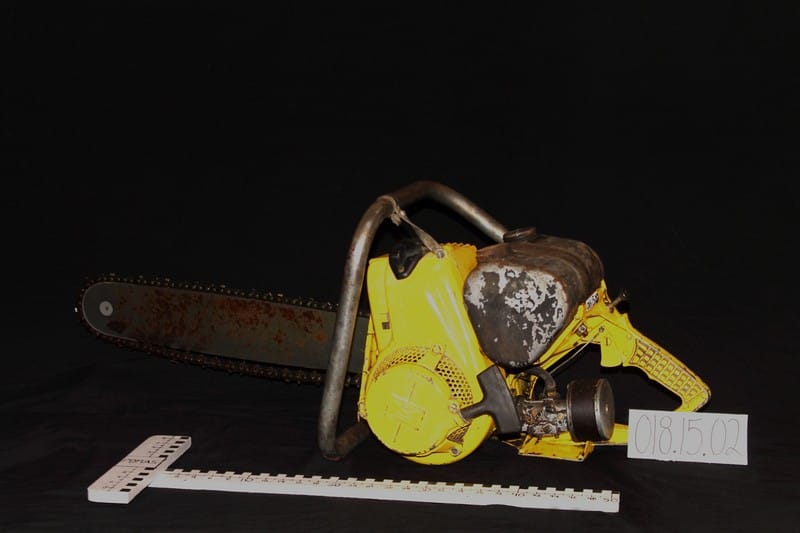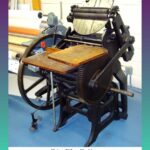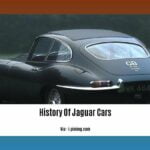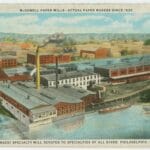Prepare to be captivated by the fascinating journey of McCulloch chainsaws, an iconic brand that has revolutionized industries. We’ll take you on a trip through time, uncovering the pivotal moments, incredible innovations, and industry-defining contributions that have made McCulloch a legend in the world of power tools. Through meticulous research and expert insights, we’ll unveil the remarkable story behind the machines that have transformed the forestry and construction landscapes for generations.
History of McCulloch Chainsaws
Ever swung an axe for hours on end, wishing for a faster, easier way to fell a tree? That’s exactly the problem McCulloch Motors Corporation tackled back in 1943. This innovative company dove headfirst into the world of outdoor power tools, and their chainsaws revolutionized forestry and construction forever.
McCulloch didn’t just make any chainsaws, they became famous for building ones that were surprisingly lightweight and shockingly powerful, especially considering these were early days for this tech. Imagine a time when a one-man chainsaw was a revelation – that was McCulloch’s impact!
Seeing the positive response to their tools, McCulloch branched out. Soon they were offering generators, hedge trimmers, string trimmers for perfect lawn edges, and even leaf blowers. Basically, if you needed to wrangle your great outdoors, McCulloch wanted to be the name you trusted.
In 2008, the Husqvarna Group, already a prominent name in the industry, acquired McCulloch. This acquisition cemented Husqvarna’s position as a leader in outdoor equipment and demonstrated the enduring legacy of the McCulloch brand.
Husqvarna continues to manufacture McCulloch chainsaws today, along with a whole lineup of other outdoor gear. So the next time you’re taming your lawn, remember McCulloch – the company that took a swing at innovation and changed the way we work with nature.
Key Points from the History of McCulloch Chainsaws:
- 1943: McCulloch Motors Corporation introduced lightweight and powerful chainsaws, revolutionizing forestry and construction.
- Expansion: The company expanded its product line to include generators, hedge trimmers, string trimmers, and leaf blowers.
- Innovation: McCulloch became known for its dedication to innovation, customer feedback, and ease of handling in its chainsaws.
- 2008: Husqvarna Group acquired McCulloch, recognizing its strong reputation and legacy.
- Present: Husqvarna continues to manufacture McCulloch chainsaws and other outdoor gear today.
How did McCulloch make his money?
This isn’t a story about a chainsaw magnate’s fortune. It’s about a power struggle between the US federal government and individual states back in the early 1800s.
James W. McCulloch was the cashier of the Second Bank of the United States branch in Baltimore. This bank, chartered by the federal government, faced opposition from the state of Maryland, which saw it as a threat to its authority.
Maryland imposed a hefty tax on the bank, hoping to force it out. McCulloch, tasked with paying this tax, refused, arguing that Maryland had no right to tax a federal institution. This led to a landmark Supreme Court case: McCulloch v. Maryland.
The Supreme Court sided with McCulloch, solidifying the idea that the federal government had “implied powers” beyond those explicitly listed in the Constitution. This ruling sent shockwaves through the nation, affirming the federal government’s upper hand in certain matters, including banking.
While this decision didn’t make McCulloch personally rich, it made him a key player in a pivotal moment in American history – a story about standing up for what you believe in, even when the stakes are high.
4 Key Takeaways from McCulloch v. Maryland:
- The Spark: McCulloch refused to pay a state tax on the Second Bank of the United States.
- Implied Powers: The Supreme Court ruled in favor of McCulloch, establishing the principle of implied powers.
- Federal Authority: The case solidified the federal government’s authority over banking and currency matters.
- Lasting Impact: McCulloch’s defiance and the Court’s decision strengthened the federal government’s role in regulating the economy and interstate commerce.
How old are McCulloch chainsaws?
The McCulloch chainsaw story began in 1948 with the introduction of the Model 5-49. This game-changing tool transformed forestry and construction work.
From the beginning, McCulloch focused on innovation and customer satisfaction, creating chainsaws known for their light weight, power, and user-friendliness. Their product line expanded to include other power tools, solidifying their reputation as a reliable brand for outdoor equipment.
The company changed hands over the years, with Black & Decker acquiring it in 1973. This led to a greater emphasis on smaller chainsaws. Today, McCulloch is part of the Husqvarna Group, continuing its legacy of producing reliable, powerful, and easy-to-use chainsaws, particularly specializing in smaller models.
Key Dates in McCulloch Chainsaw History:
- 1943: Robert Paxton McCulloch founded McCulloch Motors Corporation.
- 1948: McCulloch’s first chainsaw, the Model 5-49, was introduced.
- 1973: McCulloch sold to Black & Decker, leading to a focus on smaller saws.
- Present: Now owned by Husqvarna, McCulloch continues to produce chainsaws, primarily smaller models.
Do they still make McCulloch chainsaws?
Absolutely! McCulloch chainsaws are still buzzing along, providing homeowners and professionals with reliable tools for a variety of cutting tasks.
McCulloch has been a trusted name in the chainsaw world since 1943, known for building durable and dependable machines. They offer a diverse lineup of models, ensuring there’s a McCulloch chainsaw to fit every need and budget.
Whether you’re a seasoned pro or a weekend warrior, McCulloch likely has a chainsaw for you. You can find them at major retailers like Home Depot and Lowe’s, as well as online. If you’re looking for a tough, dependable, and affordable chainsaw, McCulloch is a brand worth considering.
What Year Was the McCulloch 610 Chainsaw Made?
Pinpointing the exact production year of your McCulloch 610 chainsaw can be tricky, but it’s likely your saw was manufactured sometime between 1985 and 1994.
Unlike some manufacturers, McCulloch didn’t use a serial number system that directly correlates to a specific year. However, markings, labels, design elements, and materials used in the saw’s construction might offer clues about its production year.
Despite the lack of precise dating, the McCulloch 610 is widely regarded as a testament to a time when chainsaws were built to last. Known for their power and simple design, many 610s are still in use today, valued for their reliability and performance.
McCulloch 610 Chainsaw – Features and Facts:
- Production Years: 1985 – 1994 (approximately)
- Engine: 60cc
- Cylinder Bore: 1.85 inches
- Stroke: 1.38 inches
- Features: Automatic oiler, chain brake/hand guard, anti-kickback features, adjustable throttle latch, fuel gauge window
- Price Range: $25 – $250 (depending on condition and location)
Why was McCulloch sued?
In 1819, McCulloch Motors Corporation found itself facing a lawsuit from the state of Maryland. The issue? Taxes. Maryland wanted to tax the Baltimore branch of the Bank of the United States, a national bank established by the federal government.
James W. McCulloch, the cashier of that bank branch, refused to pay the tax. He argued that Maryland had no right to tax a federal institution, setting the stage for a showdown between state and federal authority.
The case, McCulloch v. Maryland, landed in the Supreme Court. The Court sided with McCulloch, affirming the federal government’s implied powers under the Constitution’s Necessary and Proper Clause. This meant the government could take actions not explicitly listed in the Constitution if those actions were deemed necessary to carry out its duties.
This landmark decision had a profound impact on the balance of power between states and the federal government. It strengthened the federal government’s authority, especially regarding financial matters.
Key Points of the McCulloch v. Maryland Case:
- The Issue: Maryland’s attempt to tax the Bank of the United States
- The Argument: McCulloch’s refusal to pay, citing federal supremacy
- The Ruling: Supreme Court sided with McCulloch, affirming implied powers
- The Impact: Shifted the balance of power towards the federal government
Why Did McCulloch Not Pay the Tax?
James W. McCulloch, a cashier at the Baltimore branch of the Bank of the United States, refused to pay a tax imposed by the state of Maryland on the bank. He believed this tax was unconstitutional.
McCulloch argued that as a federal institution, the Bank of the United States was not subject to state taxation. He saw this as a case of a state government attempting to interfere with the operations of a national institution, a principle he believed was fundamentally wrong.
This disagreement led to the landmark Supreme Court case McCulloch v. Maryland. In 1819, the Court sided with McCulloch, ruling that Maryland’s tax was unconstitutional. The Court affirmed the concept of “implied powers,” stating that the federal government had powers beyond those explicitly mentioned in the Constitution.
The McCulloch v. Maryland decision was a pivotal moment in American legal history. It reinforced the supremacy of federal law over state law in cases of conflict and helped define the balance of power between state and federal governments – a balance that continues to be debated today.
Understanding McCulloch’s Refusal:
- Belief: Maryland’s tax on the Bank of the United States was unconstitutional
- Principle: State governments should not interfere with federal institutions
- Outcome: Supreme Court victory affirming federal supremacy and implied powers
How Much Did McCulloch Pay for the London Bridge?
In 1968, Robert McCulloch, the chainsaw entrepreneur, purchased London Bridge for $2.46 million. However, the total cost, including shipping and reassembly in Lake Havasu City, Arizona, was closer to $2.7 million.
McCulloch’s bold move was a calculated risk to boost tourism and put Lake Havasu City on the map. He envisioned the bridge as a unique attraction, drawing visitors eager to experience a piece of London’s history in the Arizona desert.
The relocation of London Bridge was a monumental undertaking, requiring meticulous planning and engineering expertise. The bridge was dismantled, shipped across the Atlantic, and painstakingly reconstructed in its new desert home.
Today, London Bridge stands as a testament to McCulloch’s vision. It’s a major tourist attraction, drawing visitors from around the world and proving that sometimes, the most audacious ideas yield the most remarkable results.
London Bridge – From London to Lake Havasu City:
- Purchase Price: $2.46 million
- Total Cost (estimated): $2.7 million (including shipping and reassembly)
- McCulloch’s Vision: Boost tourism and establish Lake Havasu City as a destination
- Outcome: London Bridge became a major tourist attraction, proving McCulloch’s vision.
Did McCulloch say Congress could create banks?
The heart of the matter in McCulloch v. Maryland wasn’t whether James W. McCulloch believed Congress could create banks. It was about whether Congress had the implied power to create a national bank, like the Second Bank of the United States, even though the Constitution didn’t explicitly grant that power.
McCulloch, as cashier of the bank’s Baltimore branch, argued that Maryland’s tax on the bank was unconstitutional because it interfered with a federal institution. The Supreme Court agreed, ruling that while the Constitution doesn’t explicitly mention a national bank, Congress had the implied power to create one under the Necessary and Proper Clause.
This decision was monumental. It strengthened the concept of implied powers, giving Congress more flexibility to act beyond the explicitly enumerated powers in the Constitution. It also solidified the principle of federal supremacy, giving federal law precedence over conflicting state laws.
The debate over implied powers continues to this day. Scholars and politicians debate the boundaries of congressional power and the balance between federal and state authority. McCulloch v. Maryland remains a cornerstone case in this ongoing discussion.
McCulloch v. Maryland – Beyond the Surface:
- The Core Issue: Implied powers of Congress, not McCulloch’s personal opinion on bank creation
- Supreme Court’s Stance: Congress has implied powers to enact laws “necessary and proper” for executing enumerated powers.
- Lasting Impact: The case continues to shape the debate over federalism and the scope of congressional authority.
What did William McCulloch do?
William McCulloch, a conservative Republican congressman, surprised many by becoming a champion for the Civil Rights Act of 1964. Despite representing a district with a history of segregation, McCulloch believed that doing the right thing transcended political pressure.
In 1963, McCulloch promised President Kennedy his support for civil rights legislation. He remained true to his word, working tirelessly to convince fellow Republicans of the bill’s importance.
McCulloch’s integrity and reputation as a man of principle gave him influence. His efforts were instrumental in securing enough votes to pass this landmark legislation.
Often overlooked in the historical narrative, McCulloch’s contribution to the Civil Rights Act was significant. Jacqueline Kennedy Onassis recognized his crucial role, highlighting the impact of his behind-the-scenes work.
William McCulloch’s story exemplifies the power of individual action. He transcended partisan politics, demonstrating that even in divisive times, individuals can drive meaningful change and shape a more just future.
William McCulloch’s Legacy:
- Champion for Change: A conservative Republican who became a pivotal figure in the passage of the Civil Rights Act of 1964.
- Commitment to Justice: Prioritized doing the right thing over political expediency, even when facing opposition.
- Unsung Hero: Played a crucial but often overlooked role in one of the most significant pieces of legislation in American history.
What was McCulloch convicted of?
This question has a two-part answer, referencing distinct cases:
1. James W. McCulloch and McCulloch v. Maryland:
In the context of the landmark case McCulloch v. Maryland, James W. McCulloch, a cashier for the Second Bank of the United States, was indeed found guilty in a Maryland court. His “crime” was refusing to pay a state tax levied on the bank.
McCulloch’s refusal wasn’t about personal gain but stemmed from his firm belief that Maryland overstepped its authority. He argued that taxing a federal institution like the national bank was unconstitutional. This defiance ultimately led to one of the most pivotal Supreme Court rulings in U.S. history.
2. Jack McCullough and the Murder of Maria Ridulph:
Decades later, entirely separate from the banking case, a man named Jack Daniel McCullough (formerly known as John Tessier) was convicted in 2012 for the 1957 abduction and murder of Maria Ridulph. He was sentenced to life in prison.
This case garnered significant media attention due to its cold case nature and the eventual overturning of McCullough’s conviction in 2016.
It’s essential to distinguish between these two individuals and their respective cases. While both share the name “McCulloch,” their stories are unrelated and occurred in vastly different contexts.
















